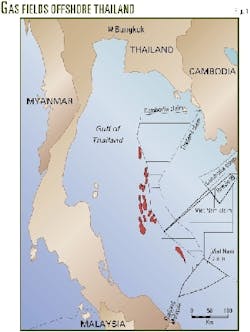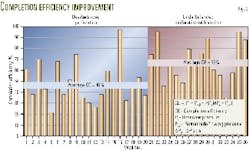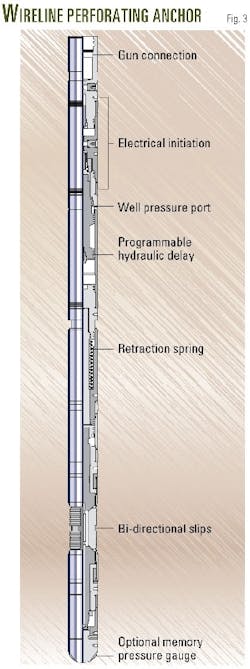Unocal Thailand Ltd. has found that a wireline anchor can effectively reduce the potential of perforating guns being blown up or down the hole while perforating underbalanced in slimhole, monobore gas wells.
The tool requires no special landing nipples or other completion hardware.
In October 1999, Unocal took receipt of the industry's first wireline perforating anchor tool that can be set independent of gun activation. Schlumberger developed the tool over a 5-month period for use in Unocal's monobore, high-temperature Gulf of Thailand wells.1
Need for an anchor
Unocal has been drilling in the Gulf of Thailand since the 1970s (Fig. 1). Operations in the area involve:
- Well depths of 9,000-14,500 ft measured depth and 7,400-10,000 ft true vertical depth (TVD).
- Water depth of 190-240 ft.
- Tender-assisted platform rigs.
- Bottomhole temperatures of 300-410° F.
- Gas and condensate production with 5-75% CO2 and 0-2% H2.
- Up to 30 sand intervals or 600-ft pay/well at a 4,000-10,000 ft TVD.
- Completion of pay intervals over months or years in a random depth sequence.
- No sand control required.
- Formation pressures of 1,200-6,000 psi.
The unique Gulf of Thailand reservoirs create a perforating challenge. They are highly faulted, compartmentalized and generally not laterally extensive, which makes it difficult to predict the amount of depletion and communication between sands.
Production from the 27/8-in. monobore gas wells comes from multiple zones and is commingled. Cross flow between zones can exceed 15 MMscfd, with pressures ranging from 1,200 to 6,000 psi.
The level and direction of cross flow is almost impossible to predict because very little formation pressure data are available from wireline testing tools. The cross flow can cause high differential flow between zones, which plays havoc on perforating equipment.
Wireline tools can be blown up or down the wellbore when a gun is fired. This occasionally results in a fishing job, which dramatically increases the overall completion time and increases the chance of losing reserves.
Before 1997, Unocal perforated the wells either balanced or overbalanced to mitigate fishing problems.
These techniques, however, did not provide good perforation clean up and resulted in high skins and thus less than optimal hydrocarbon recovery.
Unocal, therefore, investigated options for efficiently perforating underbalanced via typical conveyance systems such as tubing, coiled tubing, slick line, and electric wireline.
It deemed the first three methods unsuitable for operational or economic reasons and only explored the electric wireline option.
In addition to being wireline-based, the optimum perforation method needed to:
- Be capable of deep penetration. Gulf of Thailand experience has shown that initial completion fluid invasion can be deep, perhaps beyond the perforation penetration of the scallop gun systems traditionally used. The new method required perforations that could consistently extend beyond invasion and into virgin formation.
- Incorporate the advantages of underbalanced perforating and immediate flow back from each zone perforated. These techniques would eliminate the added completion fluid invasion that can occur during perforating and provide immediate perforation clean up to reduce skin and improve productivity.
- Eliminate fishing or loss of tools. The high-pressure differentials that can occur between zones required a method to keep downhole tools from becoming detached from the wireline.
Addressing gun issues
The primary goal of perforating is to create a clean conduit into uninvaded formation so that the well will flow back immediately.
When one perforates with the formation pressure exceeding wellbore pressure, or underbalanced, differential pressure can clean up the near-wellbore invasion and perforation debris, thus reducing the skin.
Unocal, therefore, changed from scallop guns to deeper penetrating, expendable, or semiexpendable guns. This approach, however, created an undesirable amount of gun debris, which was a problem in the monobore wells. The final system Unocal used was a newly developed, 2-in. high shot density (HSD) gun loaded with high-performance charges at six shots/ft.
A remaining challenge, however, was to keep the gun system stationary while shooting underbalanced in 27/8-in. tubing. When one perforated a full interval underbalanced, reservoir pressure often blew the guns up or down the hole, damaging downhole equipment and causing expensive fishing operations or loss of the well.
To alleviate the pressure differential, Unocal's interim practice was to shoot only one or two equalizing holes and wait hours and occasionally days for gradual equalization. This solution was time consuming and did nothing to reduce skin damage but did reduce the number of lost tools.
Unocal began experimenting with methods to immobilize the perforating assembly. Reactive tools, which activate slips when rapid upward movements occur after a gun is fired, proved unsuccessful even after modifications. It also deemed unsuitable the addition of landing or anchoring features to the 27/8-in. monobore tubulars.
In June 1999, Unocal approached Schlumberger with the following request to develop a system that would:
- Provide deep perforations into uninvaded formation in multiple zones per well with little damage or skin after clean up. The tools would be run on wireline in underbalanced and high-temperature conditions.
- Eliminate gun movement and debris that could lead to fishing, as well as the time spent shooting a few preliminary perforations to equalize the pressure differential.
The expected skin reduction would potentially increase recoverable reserves. A team at Schlumberger's technology center in Rosharon, Tex., developed the tool.
Tool design
In October 1999, Schlumberger delivered an operational tool to Thailand. Run below the high-performance HSD gun, the 21/8-in. OD wireline perforating anchor tool (WPAT) positively anchors the tool string to the tubing prior to firing the gun (Fig. 2).
The tool holds up to 17,000 lb, in either direction, and releases after a selectively preprogrammed time interval.
If needed, an upward jarring or pulling by wireline will aid slip retraction.
The tools delivered to Unocal use downhole pressure to activate a hydraulic-mechanical system that generates the holding force. An alternative configuration uses a high-pressure gas canister housed within the tool for the downhole energy source.
Field results
The first trial runs for Unocal Thailand were in December 1999. Three trials involved running, setting, and releasing the tool without attempting to fire the guns. Two subsequent runs fired the guns after setting the anchor but with the well at static conditions. All runs were successful.
On Feb. 12, 2000, the tool was used to perforate a 10-ft interval underbalanced while the well flowed 4 MMscfd. The anchor tool held the gun in place and was retrieved as planned. The interval's calculated skin of 3 was much less than the field's typical average skin of 19.
Subsequent runs generally were successful for a new concept tool although occasionally tool release times were excessive or slips dragged after release.
Several small changes to the initial design have eliminated these problems.
To determine optimum engineering design, Unocal ran its first six assigned tools with varying combinations of parameters such as shot density, underbalanced amount, completion fluid type, and flow periods.
Many anchor runs also included a high-performance, electronic-memory, pressure-temperature gauge to evaluate the perforating process.
This information has been used to try to minimize operating time and optimize formation skin reduction techniques.
The pressure data helped to identify significant unexpected cross flow in one previously perforated well and provided information on zones that previously had no pressure measurements.
The current operational sequence for an underbalanced perforating job in a new well is as follows:
- Run in hole and set anchor tool on depth.
- Perforate and flow without choke to unload completion fluid for 30 min.
- Shut in well prior to tool release.
- Pull out of hole.
- Flow and unload remaining completion fluid.
- Flow test well (optional).
For subsequent dynamic underbalanced perforating with intervals open, the procedure is as follows:
- Shut in and run gun-anchor tool in hole.
- Set anchor tool on depth.
- Flow well with full choke for 10 min.
- Fire gun with the well flowing.
- Continue flowing 10 min for clean up.
- Shut in well prior to tool release.
- Flow test and run pressure build-up survey.
The 15 pressure build-up tests taken after perforating with the anchor tool showed an average completion efficiency of 69.
This represents a 44% improvement over an average 48 efficiency before use of the anchor tool (Fig. 3).
Next steps
Schlumberger continues to refine the tool. As of Nov. 15, 2000, Unocal Thailand had made more than 100 anchor runs and also received kits to configure some WPATs for gas-canister operation.
Unocal Indonesia Co. as well as PTT Exploration & Production Public Co. Ltd. (PTTEP) are two other companies planning to use the tool in 31/2-in. monobore completions.
Acknowledgments
The authors thank the management of Unocal Thailand and Schlumberger for permission to publish the case study.
Reference
- 1. Callahan III, E.R., and Schul, G., "Slimhole Development in the Gulf of Thailand," Paper No. SPE 38053, April 1997.
The authors-
Christopher Jason Pinto is a drilling and workover engineer for Unocal Thailand Ltd., Bangkok. He previously worked as a drilling engineer with Schlumberger. Pinto has a BS in petroleum engineering from the Colorado School of Mines, Golden.
Charles R. Klimo is the Unocal account manager for Schlumberger Overseas SA, Bangkok. He has worked for Schumberger in teaching, sales, interpretation, and alliance coordination. Klimo has a BS in electrical engineering from the Illinois Institute of Technology.
Simon Farrant is the wireline-perforating manager at the Schlumberger's reservoir completions technology center in Rosharon, Tex. He previously was Schlumberger's wireline field engineer in Oman and location manager for Offshore Thailand. Farrant has a BS in geophysics and planetary physics from the University of Newcastle Upon Tyne and an M.Eng. in petroleum engineering from Heriot-Watt University, Edinburgh, Scotland.





